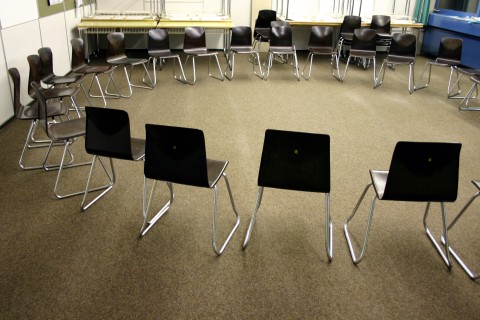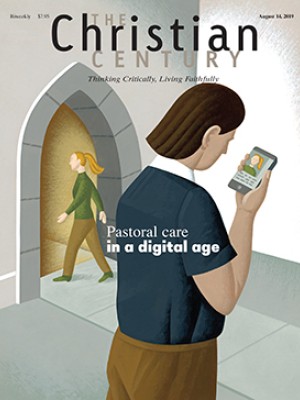What if classrooms were shaped by a restorative justice sensibility?
Creating space for a different kind of engagement

“Hospitality calls me to consider the singularity of each person, the diversity of needs.” Mary Rose O’Reilley offers this insight in her slim gem of a book Radical Presence: Teaching as Contemplative Practice. Two years ago, I hosted a conversation about it with several colleagues. We came from different disciplines, united in our desire to think more deeply about pedagogy, more critically about unwelcome trends in higher education, and more clearly about our hunch that vulnerability in the classroom is a good worth pursuing. We spent a satisfying two hours together, and in the months since—as our paths have crossed, mostly in perfunctory meetings—we’ve remembered it fondly. But our lives are busy. Those unwelcome trends continue to rob us of time and energy.
This past year I recalled that experience in the context of other challenges. In response to events in our community and in the world, another campus group came together to talk about restorative justice. It’s a concept I always cover briefly when I teach Christian ethics. I lingered longer on it this spring in light of what feels like a fraught, fragile time.
Read our latest issue or browse back issues.
Restorative justice names a constellation of convictions and practices that redefines wrongdoing broadly and its impacts specifically. Where the modern judicial system centers on offenders and their punishment, restorative justice expands the circle to those who have been victimized and to the wider community.
A core idea is that harm creates social obligations—the necessity of putting things right, repairing what’s broken. This flows from a worldview that imagines that we live in a web of mutuality—and that if a rupture in that web is to be mended, this will happen less through arbitrarily applied punitive measures and more through the hard work of conversation and collaboration.
Victims, offenders, and their communities are involved in the process of justice seeking. Victims’ needs are paramount, but support for offenders in carrying out their obligations is also essential. On college campuses, for example, restorative practices have transformed how student conduct committees conceive of their work—and of how the needs of the harmed, those causing harm, and the community itself can be meaningfully addressed. There’s nothing romantic about this, and there are no guarantees. (It’s also important to note that there are subtleties and disagreement within the discourse of restorative justice that can’t be elaborated here.)
Restorative justice seeks first of all to tell the truth about what is going on. It isn’t primarily about forgiveness or reconciliation, though it can provide a context where they might be possible. And it doesn’t imply a return to the past. The preconflict status quo, after all, is often what gives rise to injustice in the first place. Some practitioners prefer the word transformative to restorative: there may be little of value to be restored to.
Restorative justice isn’t new. Howard Zehr, considered by many its founder, began working as a practitioner and theorist in the late 1970s. Conflict resolution practices from First Nation communities in Canada have informed the movement from the beginning, restorative justice undergirds the juvenile justice system in New Zealand, and communities across the globe have long been exploring what it means to be restorative cities. In recent years Bryan Stevenson of the Equal Justice Initiative and Pádraig ÓTuama at Corrymeela in Northern Ireland have brought restorative justice principles and practices to light in powerful ways.
But what does it have to do with a classroom?
It isn’t so much that restorative justice is a topic to teach, though sometimes it is that. Rather, it can shape a sensibility, supply a framework, or create a space for students and teachers to be vulnerably present to the work and to each other, whether the subject at hand is Christian ethics or organic chemistry. In an education system that makes fetishes of standardization and methodology, this is like water in the desert. When silence, for example, is cultivated in a classroom, the possibilities of genuine listening and deeper comprehension, of regarding the singular gifts of each person, are opened up.
O’Reilley notes that when such risks are taken, classrooms get a lot more “edgy and astonishing.” There may be less consensus or agreement; the teacher may feel a bit out of control. Yet the dialectic of speech and silence, skillfully executed, constitutes what O’Reilley calls a liturgy of assimilation and forgiveness. We are brought together, but there is always more work to do.
A restorative justice sensibility also has implications beyond the courts and the classroom. What if church meetings disavowed entrenched patterns of antagonism adopted uncritically from courtrooms and boardrooms? Could a restorative justice approach to hard conversation help reveal that racism, sexism, and other social ills are systemic and structural, embedded in policies, bureaucracies, and the law of the land?
As a way of seeing and being in the world, restorative justice resonates with much of Christianity’s theological anthropology. No one is expendable; respect and mercy are not only for the “deserving.” What if this recognition could transform dead-end debates around reparations for slavery, the inequitable treatment of queer people, and the atrocities at our southern border?
Restorative justice seeks to tell the truth. If only, given the many spaces where harm goes unchallenged, we could start with that.
A version of this article appears in the print edition under the title “Vulnerability in the classroom."






